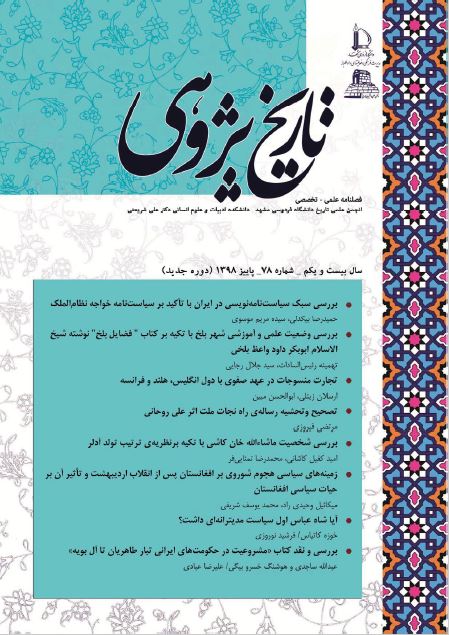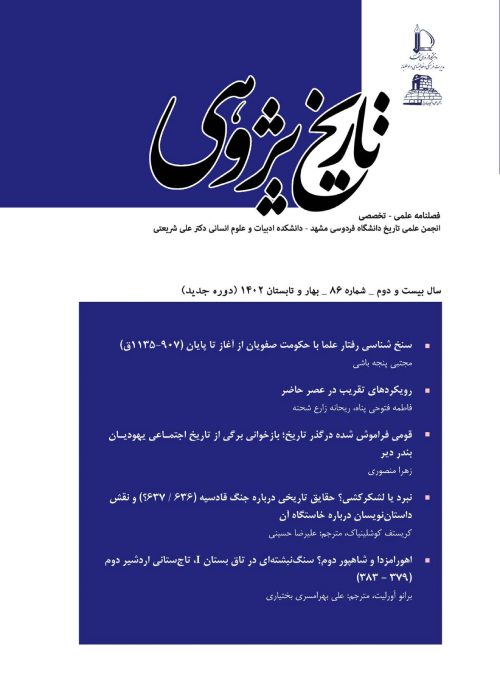فهرست مطالب

نشریه تاریخ پژوهی
پیاپی 78 (پاییز 1398)
- تاریخ انتشار: 1398/08/20
- تعداد عناوین: 8
- ترجمه
- معرفی و نقد کتاب
-
Page 7
The history of SiyƗsatnƗmeh (The Book of Statecraft) writing in Iran goes back to the fall of the Sassanid regime and the arrival of Islam. As generally, SiyƗsatnƗmeh was a guide book for rulers to retain state and to prevent its weakening. The usual way of writing these books had been in style of advising rulers with a combination of stories, illustrations, narratives and hadiths. The SiyƗsatnƗmeh used to pen by vuzarƗ, philosophers, adibƗn and fuqahƗ. Most of these works are based on principles such as: appointing Shah at the head of all affairs, Shah as a shadow of god, paying attention to justice, pragmatism, consideration of political realities, the parallelism of religion and politics and fate. Khwaja Nizam al-Mulk was the minister of two Seljuk Shahs, Alp ArslƗn and Malik-Shah, who was born in 408AH and by order of the Shah of Seljuk, he wrote the book of Siyar al-mulûk in fifty chapters. The structure of Khwaja Nizam al-Mulk's book is based on five entities: monarchy, ministry, judiciary, military, and administrative body, which include: bureaucratic affairs and the regulation of the affairs of the court and the administrative arrangements of the court. Khwaja Nizam al-Mulk's Siyar al-mulûk and Al-Ghazali's NasƯhatul Mulnjk(The Counseling Kings) are the richest SiyƗsatnƗmeh in Iranian history. Studies have shown that although these two SiyƗsatnƗmehs are akin to each other, the differences between Khawaja and Al-Ghazali's approaches lead to different approaches in dealing with issues.
Keywords: SiyƗsatnƗmeh, Nizam al-Mulk, Siyar al-mulûk, NasƯhatul Mulnjk -
Page 29
Quarter Balkh is one of the most important cities of Khorasan region, which is very important in the medieval scientific and educational discussion. In order to examine the scientific and cultural status of the city, various sources including references, political sources, encyclopedias, and poems, are significant. Another source for understanding this topic is the local history of the period. FazեւƗҴil-i Balkh book, by Balkh preacher, is one of the reliable books that help to understand the scientific-educational status of Balkh. This paper aims to analyze the scientific and educational status of Balkh city in the given centuries regarding FazեւƗҴil-i Balkh book and to answer the questions of what educational institutions and disciplines are discussed in this book and to which cities were scientific trips made according to this text? This is a descriptive-analytical study based on library resources. Of the seventy people mentioned in this book in the 2nd to 6th centuries, it was found that the scholarly field of hadith, fiqh and Quranic sciences were the most center of attention, and scientific trips to Iraq and the cities of Baghdad and Basra and more books which were written in the fields of fiqh, Philosophy, wisdom and the Quranic sciences had been the most books.
Keywords: Balkh virtues, Balkh preacher, Balkh city, educational status, scientists, mosques, schools, scientific trips -
Page 61
The rise and establishment of the Safavid state resulted in dramatic changes in Iranian foreign policy; relations with other countries and the expansion of trade in the Safavid era became stronger, and these states opened up relations with the Safavid state for political and commercial purposes. The purpose of the present study is to investigate the textile trade in the Safavid era with the countries of England, the Netherlands and France. The main question is, what textiles were exported in the Safavid period and what kind of fabrics were imported into the country? The main hypothesis in response to this question is that the formation of the Safavid state brought political stability, and two factors threatening the Ottoman Empire and protecting the Safavid Shahs from trading had an effective role in expanding relations with European states. The research method of this study is historical and comparative. Moreover, the method of doing this work is in the form of libraries, and the way of data collection is by the method of extraction. The main findings of this study show that the formation of the Safavid state led to the political unity of the country, the security of roads and the prosperity of trade and commerce, especially the textile trade.
Keywords: Safavids, England, Holland, France, Textile Trade -
Page 85
In this article, the treatise of the way of saving the nation: a summary of Nader Shah's action on trying to bring the two Islamic sects [Sunni and Shia Islam] closer together by Ali Rouhani is edited and annotated. In this treatise, the writer describes and details Nader Shah's actions in respect to Jaޏfari maڴhab, the proximity of Islamic Schools of Thought and the relationship with the Ottoman Empire especially from the religious point of view. At the end of the treaties, an explanation of Mohammad Taghi Mojtahed regarding the treatise is included. The treatiese with the Registration Number of 41872 is maintained in the library of Astan Quds Razavi.
Keywords: Nader Shah Afshar, Jaޏfari maڴhab, Ummah, the OttomanEmpire -
Page 103
Mashallah Khan Kashi was the ringleader of the Naibian gunmen who had occupied areas of central Iran in the Qajar era for many years, and the central government eventually managed to end their rebellion in 1298. Adler, a neo- Freudian psychoanalyst, has argued that the order of the birth of people (first child, second child, and last-child) influences their character differently. The social environment of each person in the family varies from the others, and this leads to the formation of different personalities among the children of the family. Mashallah Khan was the first son of a family. Regarding the relationship between personality and birth order, the influence of birth order of Mashaallah Khan on continuity of Naibian power in the last years of Qajar era deserves to be studied. The research method of this` paper is descriptive-analytical based on library studies. The results indicate that there is a deep connection between the character of Mashaallah Khan and his birth order. His character, according to Adler's description of the senior child, has the following characteristics: upremacist, organizer, authoritarian, insensitive to others, conservative and finally criminal as the other criminals who are mostly the senior child. It is attributed that these characteristics were highly influential on the continuity and strength of the Naibians until 1298, as well as the stronger organization of this group.
Keywords: Mashaallah Khan Kashi, First child, Adler's birth order, Naibian -
Page 129
Relations between Afghanistan and the Soviet Union Since the independence of Afghanistan which was taken by Amanullah Khan from Britain to the fall of rule of Dr Najibullah (1992) by the Mujahideen has been one of the most critical periods in Afghan's contemporary history. Relations between Afghanistan and the USSR during the time had always been rising and falling, and it did not leave a positive image in the historical memory of the Afghan people, especially since the formation of the Communist government. Russia has long coveted the territory of Afghanistan, and has enjoyed every opportunity for attacking to the territory; invasion of the red army on 1979 and deployment in there is one an undeniable evidence for it. The aim of this research is to clarify the factors and causes of the Soviet invasion to Afghanistan and to find out the factors that influence the Soviet campaign in Afghanistan and the impact and consequences of the invasion on the political and social situation in the country. The findings of the study indicate that the Soviets expanded the sphere of influence to secure itself against its neighbors and spreading own ideology, as for confronting it, west entered that resulted in forming national and religious opposition in Afghanistan and triggered a civil war that has been continued until today. The method of this study is mostly library. From an essential perspective, it is based on a historical method that its basis is description and analysis. Moreover, in this research, the recent works of Afghanistan and foreigner researcher have been enjoyed.
Keywords: the Soviet Union, Afghanistan, invasion, factors


